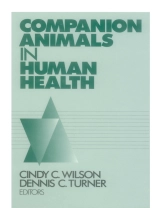Exactly how do animals affect their companion humans′ quality of life? The 7th International Conference on Animals, Health, and Quality of Life set out to explore this question. A major result of this quest was Companion Animals in Human Health , a careful selection of jurored and invited papers from that conference. The articles address human animal interaction (HAI) according to the elements that define quality of life: physical, mental/emotional, and social health; functional health; and general well-being. Beginning with an overview of human animal interaction from historical and value perspectives, the authors develop a conceptual framework for HAI research and quality of life measurement. They then go on to explore the psychosocial and physiological impact of HAI. The concluding sections address the role of companion animals in human development and the training and welfare of animals in therapeutic programs.
As a state-of-the-science document, Companion Animals in Human Health is must reading for all health and social science professionals caring for clients who already have companion animals or for clients who might benefit from such interaction and thus will be of interest to those in the fields of clinical psychology, cognition, developmental psychology, family studies, gerontology, nursing, patient care, psychology, public health, and sociology.
สารบัญ
Introduction – Cindy C Wilson
PART ONE: HISTORICAL AND VALUE PERSPECTIVE
Effects of Pet Contact on Human Well-Being – Thomas Garrity and Lorann Stallones
Perspectives on Animal-Assisted Activities and Therapy – Linda Hines and Maureen Fredrickson
Hippotherapy and Therapeutic Riding – Jane Copeland-Fitzpatrick and Jean Tebay
An International Review
PART TWO: BEYOND HEALTH: EXTENDING THE DEFINITION OF HEALTH TO QUALITY OF LIFE
A Conceptual Framework for Human-Animal Interaction Research – Cindy C Wilson
The Challenge Revisited
Models for Measuring Quality of Life – Ivan Barofsky and Andrew Rowan
Implications for Human-Animal Interaction Research
PART THREE: QUALITY OF LIFE OUTCOMES: PSYCHOSOCIAL ASPECTS OF HUMAN ANIMAL INTERACTIONS
Introduction – Cindy C Wilson
A Theoretical Basis for Health Benefits of Pet Ownership – Glyn Collis and June Mc Nicholas
Attachment versus Psychological Support
Loneliness, Stress and Human-Animal Attachment among Older Adults – Carolyn P Keil
The Relationship between Attachment to Companion Animals and Self-Esteem – Sandra Lookabaugh Triebenbacher
A Development Perspective
Blind People and their Dogs – Melanie Steffens and Reinhold Bergler
An Empirical Study on Changes in Everyday Life, in Self-Experience and in Communication
PART FOUR: QUALITY OF LIFE OUTCOMES: THE RELEVANCE OF ANIMALS TO CARDIOVASCULAR HEALTH
Introduction – Cindy C Wilson
Animals and Cardiovascular Health – Warwick Anderson and Anthony Dart
Could Type A (Coronary Prone) Personality Explain the Association between Pet Ownership and Health? – June Mc Nicholas and Glyn Collis
Pet Ownership, Social Support and One Year Survival after Acute Myocardial Infarction in the Cardiac Arrhythmia Suppression – Erika Friedmann
The Effect of a Therapy Dog on Socialization and Physiological Indicators of Stress in Person′s Diagnosed with Alzheimer′s Disease – Kathryn Batson et al
PART FIVE: HUMAN GROWTH AND DEVELOPMENT: AGE SPECIFIC QUALITY OF LIFE OUTCOMES
Introduction – Cindy C Wilson
The Role of Companions Animals in Human Development – Gail Melson
Impact of Pet Ownership on the Well-Being of Adolescents with Few Familial Resources – Nancy M Bodmer
PART SIX: ANIMAL ASSISTED THERAPY PROGRAMS: DYNAMIC INTERACTIONS WHICH IMPACT QUALITY OF LIFE
Introduction – Cindy C Wilson
The Importance of Training Standards and Policy for Service Animals – Susan Duncan
Companion Animal Welfare in Private and Institutional Settings – Robert Hubrecht and Dennis C Turner












